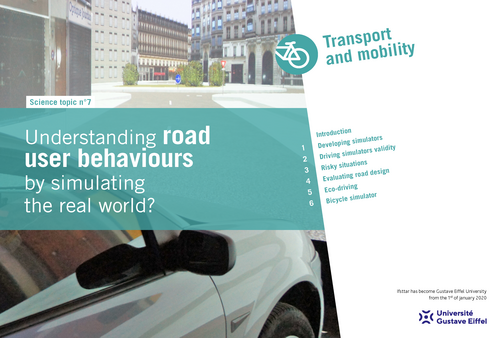Understanding road user behaviours by simulating the real world?
Simulating reality and being able to move about in a virtual world and interact with virtual entities is no longer a dream worthy of a science fiction novel. Devices that transform the virtual into reality have existed for more than 50 years. Driving simulators are virtual reality devices that make it possible for subjects to perform complex tasks cheaply or allow them to carry out tasks that would be too dangerous in a real situation.
There are several types of movement simulators, which are used for different purposes:
- The most impressive have been developed by motor vehicle manufacturers and are used to study vehicle dynamics and to validate vehicle components.
- At the other extreme, inexpensive driving simulators are used for driver training and to increase awareness of road safety issues. Their chief purpose is to allow drivers to encounter a variety of scenarios that they may meet during real driving, including accident scenarios.
- Finally, universities and research institutes, such as Gustave Eiffel University, conduct research work that aims to improve these virtual reality devices and use them to study the behaviour of drivers and road users in general.
Varied uses for simulators
By studying road user behaviour it is possible to investigate topics as varied as the influence of medication, the design and evaluation of new driving aids, the impact of new regulations or the appraisal of new road designs. They are also used for training and to raise awareness among diffe-rent groups of road users. Last, simulators can be used to prepare for social changes as society becomes more environmentally responsible and the nature of the road changes as vehicles become more automated and active modes such as walking and cycling regain popularity. In the last few years, Gustave Eiffel University has also started to simulate the movement of vulnerable road users. It was the first Institute to develop a road.
The qualities and limitations of simulators
Simulators have many qualities. They mean the driving environment can be easily modified and participants can be placed in situations that are likely to give rise to an accident without any risk. They also make it possible to control experimen-tal conditions and reproduce them as often as necessary for each participant.
However, some limitations must be borne in mind. As in the case of every experiment, those conducted on a simulator are performed in a aboratory. Applying the results to real situations and general cases requires researchers to carefully select the experimental conditions. To do this, they draw on their research experience and the knowledge of the rest of the scientific community. The question of the validity of simulators is nevertheless unresolved, and needs further study. Interested readers may refer to the article “How to make relevant a virtual reality situation?”.
The simulation of driving and movement at Gustave Eiffel University
Driving simulation has been an important feature of our laboratories’ activities for over 20 years, and it is continuing to gain ground. A number of Gustave Eiffel University's laboratories have been involved in research in this area which has resulted in two complementary software packages: “Archisim/Sim2” for movement simulation and “pro-SiVIC Recherche” for the simulation of sensors. Ten or so simulators of different types are also located on Gustave Eiffel University's four campus.
In the last few years, Gustave Eiffel University has also started to simulate the movement of vulnerable road users. It was the first Institute to develop a road rossing simulator for pedestrians. It is also one of the few research institutes to have started to develop a motorcycle simulator and a bicycle simulator.
Apart from these design activities, simulators are used for research in a number of disciplines uch as virtual reality, artificial intelligence and psychology. This research deals with, for example, the validity of simulators, multisensory ueing and the peopling of virtual scenes. Their role is both to improve simulators and provide the fundamental knowledge required to make good use of them.
Driving simulators are virtual reality devices that make it possible to perform complex tasks at reduced cost or too dangerous for the driver in real situations.

Photo credit LMA laboratory / Gustave Eiffel University
Summary
Introduction
Developing movement simulators for the study of behaviour
How to make relevant a virtual reality situation?
Studiying risk situations safely
Evaluating road design through driving simulators
- Par Jean-Michel Auberlet
- Par Lara Désiré
- Par Florence Rosey
Developing and evaluating eco-driving aid systems on simulator
Facilitating urban cycling using simulation
Identity card of the science topic
| Title: | Understanding road user behaviours by simulating the real world? |
| Coordinator: | Stéphane Caro |
| Authors: | Fabrice Vienne, Stéphane Caro, Régis Lobjois, Catherine Berthelon, Jean-Michel Auberlet, Lara Désiré, Florence Rosey, Rochdi Trigui, Dominique Gruyer, Olivier Orfila, Hélène Tattegrain, Nadine Chaurand |
| Collection: | Ifsttar sciences topics |
| Version: | PDF for free download in web and printversions |
| Licence: | Creative Common CC BY-SA 4.0 |
| Publication: | February 2016 |
| Languages: | French and english |
| Keywords: | Innovation, simulation, driving, behavior, pedestrians, vehicle, Ifsttar science topics |

